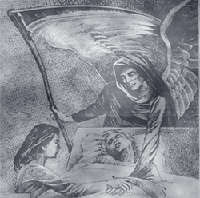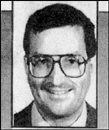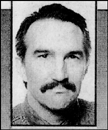

























|
September/October, 1997 Volume XII Number 8

Defining "compassion"
Ending suffering not ending life
by Michael R. Jackson, M.D. and Kenneth A. Feucht, M.D.
Syndicated columnist Ellen Goodman recently wrote that what troubles her most about the Netherlands' acceptance of physician-assisted suicide is that "between 900 and 1,000 patients a year die from what they call `non-voluntary euthanasia.'" We share her concern, for the extent of the problem is in fact far worse.
Herbert Hendlin, executive director of American Suicide Foundation and professor of psychiatry at New York Medical College, elaborates in his just-released book, Seduced by Death. The Dutch government-sponsored Remmelink Commission reviewed 49,000 cases of physician-assisted suicide and found that in more than half "decisions that might or were intended to end the life of the patient were made without consulting the patient."
The American Medical Association and more than 50 other state and national medical societies now have taken a strong stand against active euthanasia and physician-assisted suicide. The U.S. Congress has voted to ban federal funding of assisted suicide. At the same time, the man on the street along with popular columnists are far more likely to side with the Netherlands and even with Jack Kevorkian. Why?
To begin with, the truth is not being told. Even in Holland, the acknowledged world leader in euthanasia, life seems to be going on as it always has. But beneath the surface is a deadly reality: In 1995 more than 50 percent of all patients who die while under medical care were hastened to their deaths by their doctors.
Dutch physician Richard Fenigsen reports that of a total 115,000 deaths, 57,800 ot 50.2 percent resulted from euthanasia, assisted suicide, lethal overdose of morphine, and withdrawal or withholding of non-futile life support. In 62 percent of cases, this was done without the patient's consent or knowledge.
This is the real-world laboratory where physician-assisted suicide has become routine and anything but rare.
It is the doctors who inform the patients, decide on euthanasia, choose their consultants, decide to follow or disregard some of the "rules," keep records, compose the reports on which their actions are judged or decide not to report cases at all.
Another part of the explanation is found in the deceptive way that statistics regarding euthanasia are generated. For example, beginning in 1995, deaths are not recorded as due to euthanasia when patients have died of morphine overdose if doctors simply state that the lethal dose was given "without the intention but reckoning with the probability, or certainty, of causing death," or "without the intention but in the hope to cause death." In reality, more people than ever are actively euthanized while a change in terminology hides the terrible truth.
We all respond to the emotional appeal for "death with dignity." Unfortunately, euphemism's hide real content. Harvard physician Ezekiel J. Emanuel reveals: "The chief justification for (advocating) euthanasia is to provide relief for patients suffering excruciating pain. But these patients are not the ones who want euthanasia."
First of all, great advances in pain control are available today, though they do need to be more widely understood and used. Secondly, medical research has revealed it is depression, anxiety, and hopelessness that overwhelmingly drive patients toward assisted death, not pain.
Is it really "compassionate" to kill a depressed but otherwise healthy person when a few weeks of anti-depressant therapy may well have changed his or her mind? And what could be more depressing than in retirement having to depend upon a medical system and a society that view your life as expensive and so expendable that your doctor considers it routine to ask if you would rather be dead?
No wonder the elderly fear hospitals in Holland.
"Compassionate family physicians" should consider the administration of lethal doses of morphine to end suffering, writes E.H. Methvin in the Wall Street Journal, Jan. 20, But while it is more difficult to regulate the dose of morphine to control pain, this side of lethality, it is almost always possible. And when it is not, there is no significant moral or legal debate about whether it is acceptable to use as much pain medication as is necessary to completely control pain.
Huge problems arise, however, when one crosses that really quite bright line between extinguishing pain to extinguishing life. The crucial distinction is that the intent is pain control, not death.
Killing, however dressed up, is ultimately an expedient. It is always cheaper, quicker, and even emotionally easier to choose to believe one is doing the right thing by "ending suffering."
In reality, true compassion sits at the bedside, struggles through the difficulties as they arise, and works to alleviate pain as it comes. This requires the kind of care for the individual that actually maximizes the dignity of those at the end of their lives.
If the message from the Netherlands -- that flat land of slippery slopes -- teaches us anything, it is that we would do well to remember the ancient physician's dictum: primun non nocere -- above all do no harm.
 Michael R. Jackson, M.D. is a family physician Michael R. Jackson, M.D. is a family physician
 Kenneth A Feucht M.D., Ph.D., FACS, is a surgical oncologist. Kenneth A Feucht M.D., Ph.D., FACS, is a surgical oncologist.
Both are members of the Physicians for compassionate Care Education Foundation, Washington State Chapter, in Tacoma.

© 1997 Advocates for Life Ministries
|
|
